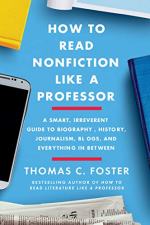|
This section contains 533 words (approx. 2 pages at 400 words per page) |

|
How to Read Nonfiction Like a Professor Summary & Study Guide Description
How to Read Nonfiction Like a Professor Summary & Study Guide includes comprehensive information and analysis to help you understand the book. This study guide contains the following sections:
This detailed literature summary also contains Topics for Discussion on How to Read Nonfiction Like a Professor by Thomas C. Foster.
The following version of this book was used to create the guide: Foster, David. How to Read Nonfiction Like a Professor. HarperCollins, 2020.
Foster's book is divided into seventeen numbered chapters, with several unnumbered and brief chapters serving as interludes throughout. For the purposes of the guide, the book is divided into five sections. The first section contains everything from the chapter "What's Going On Here?" to Chapter 3, "The Power of the Prologue." It introduces the problem of widespread and unreliable information and discusses how nonfiction writing can be a source of particular concern, since readers implicitly trust that nonfiction writing is meant to be truthful. Foster then launches into a discussion of how readers can learn to engage in critical reading by following the steps he lists throughout the book. He then explores the various genres of nonfiction the book will discuss and what structures those genres typically employ.
The second section contains everything from Chapter 4, "The Parts You Don't Read," to Chapter 7, "All in How You Look at Things." Foster continues to examine the external structure of nonfiction writing, then moves on to looking closely at the internal elements that compose nonfiction writing, such as authorial bias, references, and storytelling decisions. He also touches upon the concept of 'fake news,' both as it was traditionally understood in journalism and as it is now understood in modern discourse thanks to its usage by President Donald Trump.
The third section contains everything from Chapter 8, "Bringing the News" to Chapter 11, "Life from the Inside." Foster now takes a close look at one genre of nonfiction writing: journalism. He begins by examining newspapers and their various elements such as opinion pieces, columns, etc. He then looks beyond newspapers to explore other forms of journalism, such as participatory journalism. Next, Foster looks at creative forms of nonfiction such as that exemplified by Joan Didion, and then at essays, opinion writing, and autobiographies and memoirs. Along the way, Foster provides techniques which the reader should employ to critically read each different genre of nonfiction, since each contains its own advantages, disadvantages, and challenges for the reader seeking truth.
The fourth section contains everything from Chapter 12, "That Is So Last Year," to the brief and unnumbered chapter called "Interrogating the Text." Foster guides the reader through an examination of history and biography writing, political writing, and science and tech writing. Once more, he provides the reader with techniques for critical reading and finishes off the section with a chapter in which he summarizes all of the aforementioned techniques and questions in the 'arsenal' he has helped the reader build up so far.
The fifth section contains everything from Chapter 15, "Reading Internet Sources," to "Conclusion: Looking for Certainty in an Uncertain Time." Foster takes a deep dive into internet content -- itself a kind of nonfiction writing -- and explores how news, opinion pieces, and more are affected by the internet's trade-off between democratic participation and truthfulness. He concludes his book by recapping the critical reading techniques the reader must employ if they are to ensure they are not 'fooled' by the many misleading or deceitful works of nonfiction published both on the internet and on paper.
Read more from the Study Guide
|
This section contains 533 words (approx. 2 pages at 400 words per page) |

|



